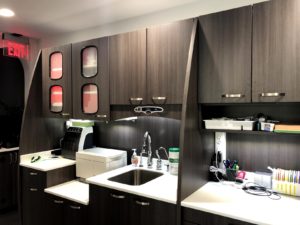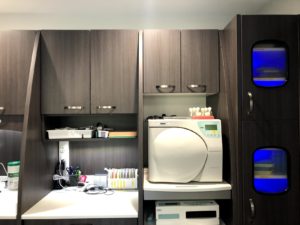-
- SCCDS (Santa Clara County Dental Society)
We strive to meet/exceed regulations mandated by Santa Clara County, California State and OSHA. Ours is one of Tom Terry’s Exceptional Dental Offices in Sunnyvale, CA.
We believe in Science and Technology. We employ and promote proactive and preventive measures.
All our staff are fully vaccinated including booster shots and diligently follow through on COVID-19 guidelines recommended by CDC, California State, OSHA, ADA, CDA and SCCDS.
-
- Sterile office environment protocols
-
- Sterilization of hand pieces, tools used for treatment
- Wipe down of X-Ray equipment, dental chair, switches
- Surface, door handles and exposed areas disinfected as necessary
-
- Sterile office environment protocols
Sterilization and Disinfection of Dental Instruments

According to the Centers for Disease Control, dental instruments are classified into three categories depending on the risk of transmitting infection. The classifications of critical, semicritical
and noncritical are based on the following criteria:
1) Critical instruments are those used to penetrate soft tissue or bone, or enter into or contact the bloodstream or other normally sterile tissue. They should be sterilized after each use. Sterilization is achieved by steam under pressure (autoclaving), dry heat, or heat/chemical vapor. Critical instruments include forceps, scalpels, bone chisels, scalers and surgical burs.
2) Semi-critical instruments are those that do not penetrate soft tissues or bone but contact mucous membranes or non-intact skin, such as mirrors, reusable impression trays and amalgam condensers. These devices also should be sterilized after each use. In some cases, however, sterilization is not feasible and, therefore, high-level disinfection is appropriate. A high-level disinfectant is registered with the U.S. Environmental Protection Agency (EPA) as a “sterilant/disinfectant” and must be labeled as such.
3) Non-critical instruments are those that come into contact only with intact skin such as external components of x-ray heads, blood pressure cuffs and pulse oximeters. Such devices have a relatively low risk of transmitting infection; and, therefore, may be reprocessed between patients by intermediate-level or low-level disinfection. An intermediate-level disinfectant is EPA-registered as a “hospital disinfectant” and will be labeled for “tuberculocidal” activity (e.g., phenolics, iodophors, and chlorine-containing compounds). A low-level disinfectant is EPA- registered as a “hospital disinfectant” but is not labeled for “tuberculocidal” activity (e.g., quaternary ammonium compounds). The tuberculocidal claim is used as a benchmark to measure germicidal potency. Germicides labeled as “hospital disinfectant”
without a tuberculocidal claim pass potency tests for activity against three representative microorganisms: Pseudomonas aeruginosa, Staphylococcus aureus, and Salmonella choleraesuis
Processing Instruments
 We sterilize all critical and semicritical dental instruments that are heat stable after each use by steam under pressure (autoclaving), dry heat, or chemical vapor. Before sterilization or high-level disinfection, we clean our instruments to remove debris. Enzymatic and non-enzymatic solutions facilitate instrument cleaning. We use heavy- duty gloves when handling contaminated instruments. We soak instruments in water and/or disinfectant/detergent as soon as possible after use to prevent drying of debris. We use instrument cassettes and mechanical cleaning (e.g., ultrasonic cleaners) to reduce direct handling of contaminated instruments. We apply rust inhibitors to protect instruments from corrosion that may result from autoclaving. We package rinsed and dried instruments before sterilization to protect them from contamination after they are removed from the sterilizer and during transport chairside or to storage.
We sterilize all critical and semicritical dental instruments that are heat stable after each use by steam under pressure (autoclaving), dry heat, or chemical vapor. Before sterilization or high-level disinfection, we clean our instruments to remove debris. Enzymatic and non-enzymatic solutions facilitate instrument cleaning. We use heavy- duty gloves when handling contaminated instruments. We soak instruments in water and/or disinfectant/detergent as soon as possible after use to prevent drying of debris. We use instrument cassettes and mechanical cleaning (e.g., ultrasonic cleaners) to reduce direct handling of contaminated instruments. We apply rust inhibitors to protect instruments from corrosion that may result from autoclaving. We package rinsed and dried instruments before sterilization to protect them from contamination after they are removed from the sterilizer and during transport chairside or to storage.
We sterilize all high-speed dental handpieces, low-speed handpiece components used intraorally and reusable prophylaxis angles. We follow the manufacturers’ instructions for cleaning, lubrication and sterilization procedures to ensure the effectiveness of the sterilization process and the longevity of these instruments. High- speed and low-speed handpieces produced today are heat tolerant, and many older heat- sensitive models can be retrofitted with heat-stable components.
Biological Indicators. Proper functioning of sterilization cycles should be verified by periodic use of spore tests called biologic indicators. Biologic indicators consist of highly resistant bacterial spores of Bacillus (Geobacillus) stearothermophilus (used to monitor steam and unsaturated chemical vapor sterilizers) or Bacillus subtilis (used for monitoring the dry heat sterilizer).
The CDC recommends that all sterilized implantable devices be quarantined until the results of biological monitoring are known.
Chemical Indicators. Chemical indicators (in the form of tape, strips, tabs and special markings on packaging material) indicate exposure to heat. Heat-sensitive chemical indicators that change color after exposure to heat do not guarantee sterilization but should be placed inside each pack, and on the outside of each pack when the internal indicator is not visible from the outside, to identify packs that have been processed through the heating cycle. Chemical indicators also should be placed in the center of a load of unwrapped instruments.
Flash Sterilization. Flash sterilization is a method for sterilizing unwrapped instruments for immediate use. This cycle operates at a higher temperature for a shorter period of time than the normal sterilization cycle. The CDC* recommends that flash sterilization not be used routinely in the dental office to sterilize patient instruments—this process should only be used in unavoidable situations.
“Cold Sterilization.” In all dental and other health-care settings, indications for the use of liquid chemical germicides to sterilize instruments (i.e., “cold sterilization”) are limited. For heat-sensitive instruments, this procedure may require up to 10 hours of exposure to a liquid chemical agent registered with the EPA as a “sterilant/disinfectant.” Instruments sterilized in this manner should be rinsed with sterile water, dried and placed in a sterile container (if not used immediately).
Contact time is the single important variable distinguishing the sterilization process from high-level disinfection with FDA-cleared liquid chemical sterilants. The FDA defines a “high- level disinfectant” as a sterilant that is used under the same contact conditions as sterilization except for a shorter immersion time.
Instrument Processing Table
|
Precleaning and cleaning solutions |
|
|
Enzymatic solutions |
Removes blood and other proteinaceous material |
|
Non-enzymatic solutions |
Removes non-specific debris |
|
Mechanical cleaners |
Washers/disinfectors or ultrasonic cleaners |
|
Rust Inhibitors |
Retards corrosion of carbon steel |
|
Sterilization Packaging Material |
|
|
Cassette |
Perforated metal or plastic/resin container used to house instruments |
|
Paper/plastic pouch |
For steam or unsaturated chemical vapor sterilizers and for storage of sterile instruments |
|
Nylon tubing |
For steam or dry heat sterilizers and for storage of sterile instruments |
|
Wrap |
For wrapping instruments and cassettes |
|
Heat sealer |
For sealing nylon tubing |
|
Sterilizers |
|
|
Steam autoclave |
Uses steam under pressure to sterilize 250 F to 273 F (time varies depending on size of load and |
|
Oven-type dry heat sterilizer |
Uses dry heat at 320 F for 1-2 hr No corrosion |
|
Rapid heat transfer-type dry heat sterilizer |
Uses circulated dry heat 375 F for 6-20 min |
|
Unsaturated chemical vapor sterilizer |
Uses unsaturated chemical vapors from formaldehyde and alcohol 273 F for 20 min |
|
Chemical Indicators |
|
|
Integrators for steam |
Chemical indicators that change color or form after certain steam sterilizer conditions (temperature, time presence of steam) |
|
Process indicator |
Chemical indicator that changes color very soon after exposure to a certain temperature |
|
Biological Monitoring |
|
|
Mail-in spore testing service |
Tests adequacy of sterilization cycle |
|
In-office spore testing system |
Test contains spore strips, culture tubes and proper incubator system |

